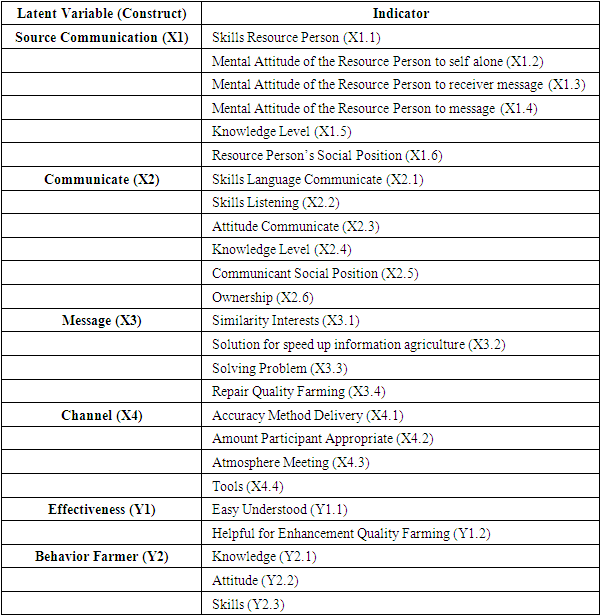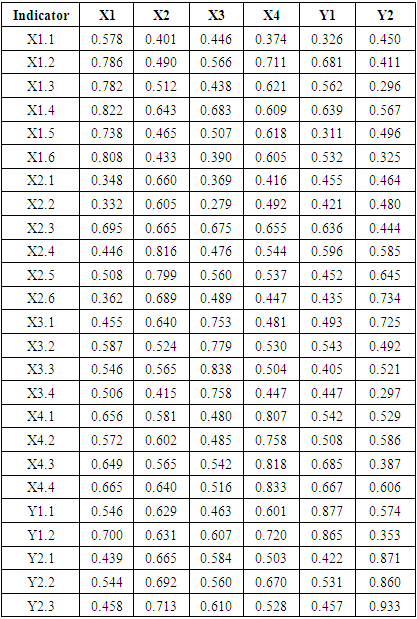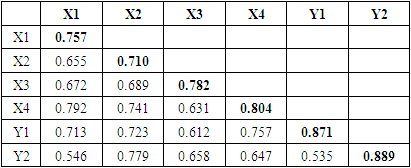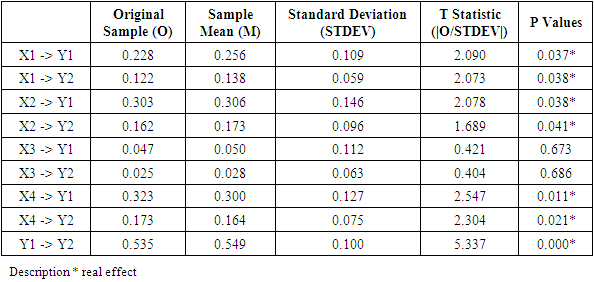-
Paper Information
- Paper Submission
-
Journal Information
- About This Journal
- Editorial Board
- Current Issue
- Archive
- Author Guidelines
- Contact Us
International Journal of Agriculture and Forestry
p-ISSN: 2165-882X e-ISSN: 2165-8846
2023; 13(1): 23-30
doi:10.5923/j.ijaf.20231301.02
Received: Oct. 17, 2023; Accepted: Nov. 3, 2023; Published: Nov. 13, 2023

Communication Effectiveness Model for Farmer Behavior Changes in Utilizing Information Technology
Ati Kusmiati1, Diah Puspaningrum2, Aryo Fajar2, Ariful Furqon3, Herman Cahyo4, Aisah Jumiati4, Agus Luthfi4
1Agribusiness Study Program University of Jember, Jember, Indonesia
2Agricultural Extension Study Program, University of Jember, Jember, Indonesia
3Informatics Study Program, University of Jember, Jember, Indonesia
4Development Economics Study Program, University of Jember, Jember, Indonesia
Correspondence to: Herman Cahyo, Development Economics Study Program, University of Jember, Jember, Indonesia.
| Email: |  |
Copyright © 2023 The Author(s). Published by Scientific & Academic Publishing.
This work is licensed under the Creative Commons Attribution International License (CC BY).
http://creativecommons.org/licenses/by/4.0/

Use of IoT in agriculture cause appearance breakthrough new more intelligent so that help activity farmer Becomes more efficient and effective. Agriculture smart (smart farming) is something method agriculture based smart technology and provide scalable and integrated data in managing agricultural processes. one form Smart Farming that can implemented by farmers village Sukorejo is making application related agriculture. The method of activity used is Participatory Action Research Model with System Development Life Cycle (SDLC) and SEM PLS. The results of the activity show that the application Germas farmer have a number of advantages that is note taking activity cultivation including schedule and expenses, farmers could fill in recording activity respective cultivation, there are information/news technique cultivation, price, institutions and stalls, there are features direct send message to PPLs. As for the weaknesses ie still in development (Prototype), the data must be related admin dientry news, prices, institutions and kiosks, still there is some bugs (program errors) that must be repaired. Variable source communication, communicant, message and channel take effect real to effectiveness communication application Germas farmer. Variable effectiveness communication take effect real to behavior farmer in use application Germas Tani. Variable Message no take effect real to effectiveness communication and behavior farmer in use application Germas farmer.
Keywords: Elements communication, Effectiveness communication, Behavior farmers, the GERMAS TANI application
Cite this paper: Ati Kusmiati, Diah Puspaningrum, Aryo Fajar, Ariful Furqon, Herman Cahyo, Aisah Jumiati, Agus Luthfi, Communication Effectiveness Model for Farmer Behavior Changes in Utilizing Information Technology, International Journal of Agriculture and Forestry, Vol. 13 No. 1, 2023, pp. 23-30. doi: 10.5923/j.ijaf.20231301.02.
Article Outline
1. Introduction
- The use of IoT in agriculture causes the emergence of new breakthroughs that are smarter so as to help agricultural activities become more efficient and effective. Smart farming is a smart farming method that is technology-based and provides measurable and integrated data in managing agricultural processes Budiharto W (2019) [6]. The purpose of Smart Farming is to increase production, achieve agricultural self-sufficiency, and analyze data on previous crops, weather, chemical content, leaf conditions, and biomass, farmers can predict agricultural results so as to obtain information that must be done next Prasetyono A (2017) [7]. In addition, Smart Farming displays information about maps and more complex data so that it simplifies, speeds up, improves target accuracy and speeds up the process Rachmawati, et al (2021) [8].The benefits of Smart Farming are quite a lot, but farmers still use conventional methods. Most farmers still use a lot of manpower, slow decision-making, and unpredictable trends in future agricultural conditions make productivity and efficiency difficult to improve. Farmers still apply conventional systems in economic or post-harvest transactions.One of the villages in Jember Regency that still uses conventional farming methods is Sukorejo Village, Bangsalsari District. The main commodities cultivated are food crops and horticulture. Farming activities are carried out for generations and conventionally without using Good Agricultural Practice (GAP). Sometimes planting time is not right because of climate change. Fertilization is carried out less balanced, the determination of the price of crops is determined more by middlemen. This results in less-than-optimal production and farm efficiency. To overcome these problems, Smart Farming can be used as a solution.Farmers as implementers of Smart Farming are faced with various obstacles. Mansyur F (2016) [9] explained that the main obstacles in implementing Smart Farming are the low level of farmer adoption, high investment costs, uncertainty in the credibility of technology companies, difficulty changing farmers' perceptions, limited internet access and the need to input a lot of data and information into software. [10] Agussabti I (2020) revealed that the use of ICT was hampered due to the low ability of farmers to access information. The obstacles faced by farmers can be overcome by providing intensive counseling. [11] Subejo, et al (2018) explained that agricultural extension is one of the determining factors for success in agricultural development. Colantoni, et al (2018) [12] revealed that developments in the implementation of agricultural extension services continue to change dynamically following global demands. One form of Smart Farming that can be applied by Sukorejo village farmers is making applications. This application can be easily accessed by farmers who have smart phones. This intelligence instrument as part of technological innovation is expected to be more effective in increasing agricultural productivity.
2. Research Methodology
- The method of determining the location of the study using purposive methode. The location determined is Sukorejo Village, Bangsalsari District, Jember Regency. The data used are Primary Data and secondary data. The data collection methods used were interviews and documentation. Primary data is obtained using the structured interview method, which is to ask questions directly to respondents based on interview guidelines (questionnaires).The sampling method is purposive sampling, namely farmers who participated in socialization and obtained information about Germas Tani from PPL and from fellow farmers who had participated in Germas Tani socialization. The research method used is the Participatory Action Research Model is a social process of collaborative learning realized by groups of people who work together in changing practice practices through interaction in a social community towards a better life as a consequence of the results of Action (Kemmis and Taggart, 2007 in Yaumi M (2016) (23).The method used to solve the first problem, namely finding the right form of smart farming, is the application of Information Technology using the System Development Life Cycle (SDLC). The life cycle of system development whose pattern is more influenced by the need to develop more effective and efficient systems. The system built is called Germas Tani. To solve the second problem related to communication elements in the delivery of Germas Tani using a qualitative approach. To solve the third problem of analyzing the effectiveness of implementing smart farming by analyzing changes in knowledge, attitudes and behavior of farmers using SEM PLS analysis. In Designing a Structural Model (Inner model) of this SEM PLS method, there are several steps, namely Designing a Structural Model (Inner model) (Chin, 1998), Designing a Measurement Model (Outer Model) (Ghozali, 2014: 37), Evaluation of Goodness Of Fit.
3. Results and Discussion
3.1. Smart Farming Application under the Name "GERMAS TANI"
- Germas Tani is a Mobile-based application used to assist farmers in carrying out activities related to the cultivation of agricultural crops. The purpose of developing the Germas Tani Application is to maximize the potential of Information and Communication Technology in the agricultural sector. The Germas Tani application development platform is based on Android smartphones with a minimum specification of Android 4.0. so that farmers are expected to be able to access the Germas Tani Application optimally on farmers' smartphones.The main features of GERMAS TANI consist of: 1. Aquaculture Activities and Financing2. Cultivation Techniques3. Commodity Prices4. Institutional5. Kiosk6. Send Message7. News8. Weather ForecastTo use the application, Germas Tani can access the https://unej.id/GermasTani and can download the available Android Application Package (APK) file (Germas Tani.apk) at the link. After successfully downloading the APK file, farmers can install the apk file by giving permission to the smartphone device so that users can use the Germas Tani application optimally. After the Germas Tani file is installed, the application is ready to run on the smartphone. The following is the design of the Mocup Germas Tani Application.The advantages and disadvantages of the Germas Tani application can be explained as follows:Excess:1. The new application was first implemented in Sukorejo Village.2. Recording of cultivation activities including schedules and expenses.3. Farmers can fill in the recording of their respective cultivation activities.4. There is information/news on cultivation techniques, prices, institutions and kiosks.5. There is a feature to directly send messages to PPL.Debilitation:1. Still under development (Prototype).2. Data must be entered by admin related to news, prices, institutions and kiosks.3. There are still some bugs (program errors) that need to be fixed.
3.2. Communication Elements in the Application of Smart Farming with the "GERMAS TANI" Application
- Communication is a process in which communicators and communicants exchange information in order to achieve mutual understanding (Rogers, 1996). The results of research in Sukorejo Village, Bangsalsari District, Jember Regency related to the effectiveness of communication of the Germas Tani Application delivered by the Sustainable Regional Development (SRD) Research and Service Group of Jember University were analyzed using Berlo Theory 1963 which consisted of 4 (four elements of communication, namely source, message, communication and messenger channel. Meanwhile, to see the extent to which the communicant understands the message conveyed by the source, an element of feedback communication will be added. Feedback in the communication process needs to be analyzed because it can provide clues to the extent to which the camouflagation that has been done is effective.The results of research related to the elements of communication elements are as follows:SourceThe source of the message in this case is the team of the Sustainable Regional Development (SRD) Research and Service Group of Jember University who made a useful application in the field of information technology, namely Germas Tani. The KeRis Dimas SRD team conveyed ideas to farmers who are members of the Farmer Group Association in Sukorejo Village, Bangsalsari District, Jember Regency, the importance of using the Germas Tani application in helping farmers solve their farming problems. Message (Germas Tani application innovation). The results of research conducted on participants who participated in the communication of the Application of Germas Tani Application are as follows:Communication skillsThe communication skills possessed by the source are good because the delivery of the Germas Tani Application given by the KeRis Dimas SRD team can be understood by participants. Although the participants' understanding varies from understanding, somewhat understanding and little understanding. Mental attitude (attitude)Mental attitude can be shown through the source's confidence in his ability to deliver the application and the source's trust in the importance of the application and the usefulness of the Germas Tani Application for target farmers. In the delivery of the Germas Tani Application, the source has enough confidence in himself as well as the benefits of the Germas Tani Application but is limited by the Application that is still in the development stage. So in the future it is necessary to refine the Germas Tani Application and be delivered to farmers.Knowledge levelSource knowledge is knowledge of everything that is proportionally talked about. Not too much or too little. The source already has knowledge of the Germas Tani application so that it is able to explain well the Germas Tani application to farmers who participate in socialization activities. However, source knowledge must be further improved by paying attention to feedback from the target community so that the Germas Tani application is in accordance with the needs of the community. This is because the Germas Tani Application needs to be improved because farmers consider that the Germas Tani Application is not ready to be applied to target farmers.Position within a social cultural systemThe KeRis Dimas SRD Team of Jember University as a resource in delivering the Germas Tani application is considered capable of providing understanding to farmers and being able to solve problems faced by farmers in their farming. In addition, the University of Jember is considered the right party and farmers have high trust in higher education institutions able to provide the right benefits to the target community.AddresseeCommunication skillsOne of the factors that determine the success of communication is the ability to communicate from the target (communicant). The communication skills of the communicants vary due to the difference in the age of the target who follow the socialization of the Germas Tani Application. It is hoped that in the future the communication target of the Germas Tani Application will be the millennial generation who are more technologically literate so that they are able to implement the Germas Tani Application well. Elderly socialization participants have limitations in mastering information technology, including skills in the use of written Indonesian and lesan.Mental attitudeMental attitude is to indicate the recipient's belief that the content of the message received is true. In this case, the target (communicant) in the socialization of the Germas Tani application expressed their willingness, interest and support in implementing the application because they considered that the application was important and useful.KnowledgeThe knowledge of the recipient of the message is knowledge that includes the communication process with which this knowledge will streamline the communication process. In the delivery of information Germas Tani, unique knowledge related to applications related to information technology varies. There are communicants who have high knowledge of information technology but there are also communicants who lack or do not know information technology.Social Position of the CommunicantThe recipient of the message in the communication of innovation is influenced by the social position of the communicant. This social position affects the effectiveness of communication. The social position of communicants who participated in the socialization of Germas Tani was both members of farmer groups and Farmer Groups in Sukorejo Village, Bangsalsari District, Jember Regency. The social position as the head of the farmer group is very important because it is expected that there will be a wider diffusion of innovations related to the Germas Tani application.MessageAccording to Cooley (1971) innovation communication will be effective if: a) there is a common interest in the needs felt by the source of the message and the recipient of the message; b) the message is a solution to the problem faced by the recipient of the message; c) the message source believes in the superiority of the message conveyed and vice versa the recipient of the message also provides assistance from the message source to solve the problems they face, and d) the message conveyed refers to satisfaction and improvement of the recipient's quality of life. The Germas Tani application is an application that aims to improve the provision of information to farmers (targets), especially related to:1. Weather information, kiosks, prices, institutions and news about agriculture; 2. Improve farm management by recording cultivation activities and the use of agricultural production factors so that the income obtained by farmers can be known in a certain planting season. 3. Increase farmers' knowledge related to cultivation through discussion forums with field agricultural extension workers (PPL) and related parties such as private extension workers, as well as independent extension workers who have experience and information related to increasing production and productivity of farming carried out by farmers. The communicant perceptions related to the Germas Tani Application are as follows: a) The Germas Tani Application is important and appropriate for farmers because it can support agricultural facilities; b) The Tani germas application is able to solve farmers' problems related to prices; c) The Germas Tani application can be used as a means to share various problems about cultivation in agriculture.Messengers channelThe communication channel used in the delivery of the Germas Tani Application is face-to-face communication (primary). That is communication without using intermediary media. The advantage of face-to-face communication is that communication becomes more effective because participants can provide direct feedback on the message given by the source. In this case, the communication model used is a two-way or circular communication model according to Newcomb (1953). In the process of submitting the Germas Tani Application, the media forum chosen is a group. Participants who participated in the socialization were as many as 25 people from various representatives of farmer groups (poktan) in Sukorejo Village, Bangsalsari District, Jember Regency. The tools used are LCD Projectors, Laptops and Mobile Phones. But the application delivery time is considered less because it is too short so it is not enough to dig in-depth information. In addition, farmers also want that the method used should directly demonstrate plots related to cultivation practices so that farmers can directly believe (beliefing by seeing).FeedbackFeedback is one of the most important elements of communication because according to Purba, et al (2020), feedback is information received as a form of response to messages that have been sent before. The feedback from communicants (message recipients) from the socialization of the Germas Tani Application is related to:a) The Germas Tani application should have advantages compared to similar applications; b) Added feature feature in the application regarding fertilizer availability information at kiosks; c) The application involves middlemen who can provide pricing information;d) Information related to good cultivation methods to increase production and productivity; e) Login to the application is made more senderhana does not use NIK because it is considered a bit risky because it is feared in the confidentiality of personal data; f) There is no need to include weather information because it is easily obtained from other sources of information; g) Added online marketing features that make it easier for farmers to do marketing;h) The method of approaching it with direct practice so that farmers can directly try; This is constrained because not all farmers have Android phones; i) It is hoped that sustainability in the application of the Germas Tani application will be carried out more often by socializing to more farmers so that more people know the Germas Tani application.Communication Effectiveness of the Application of Germas Tani Application on Changes in Farmer BehaviorThis study uses the SEM-PLS analysis method to analyze the factors that influence the effectiveness of communication on changes in farmer behavior in using the GERMAS TANI application in Sukorejo village, Bangsalsari District. The following is the determination of variables and indicators used in this study:
|
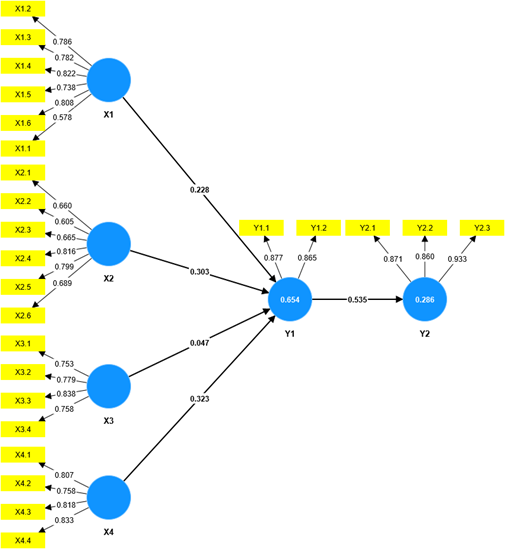 | Figure 1. SEM Model |
|
|
|
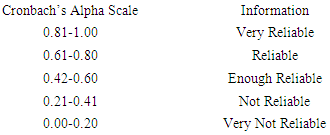 This test is needed to determine the research instrument item if used twice to measure the same symptoms will provide relatively consistent measurement results (Putka and Sackett, 2010).Testing the Structural Model (Inner Model), obtained the following results:The R-squared value (R2) is used to assess how much influence a particular independent latent variable has on the dependent latent variable. Here are the results.
This test is needed to determine the research instrument item if used twice to measure the same symptoms will provide relatively consistent measurement results (Putka and Sackett, 2010).Testing the Structural Model (Inner Model), obtained the following results:The R-squared value (R2) is used to assess how much influence a particular independent latent variable has on the dependent latent variable. Here are the results.
|
|
4. Conclusions and Recommendations
- The Germas Tani application has several advantages, namely recording cultivation activities including schedules and expenses, farmers can fill in the recording of their respective cultivation activities, there is information/news on cultivation techniques, prices, institutions and kiosks, there is a feature to directly send messages to PPL. The weaknesses are still under development (Prototype), data must be entered by the admin related to news, prices, institutions and kiosks, there are still some bugs (program errors) that must be fixed. Communication elements consist of sources, communication, messages, channels and feedback. The variables of communication sources, communicants, messages and channels have a real effect on the effectiveness of communication in the Germas Tani application. The variable of communication effectiveness has a real effect on farmer behavior in using the Germas Tani application. Message variables have no real effect on the effectiveness of communication and farmer behavior in using the Germas Tani application. The recommendation from the research that has been carried out is the need for the development of the Germas Tani application and the need for additional socialization and assistance to all farmers.
 Abstract
Abstract Reference
Reference Full-Text PDF
Full-Text PDF Full-text HTML
Full-text HTML